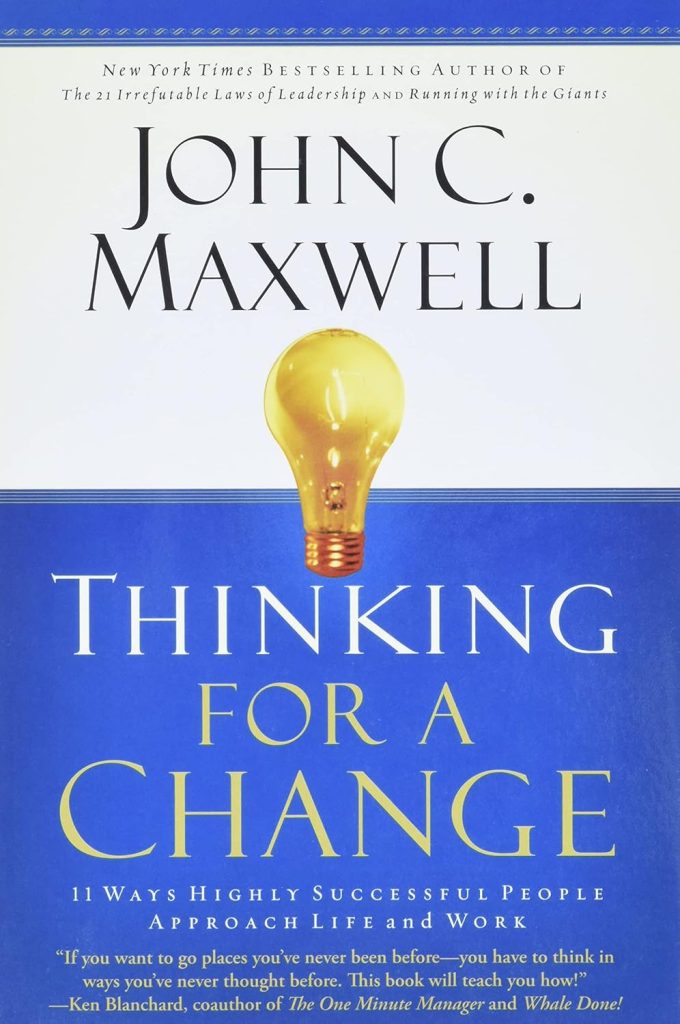
Author: John C. Maxwell
Publisher: Center Street
Published Date: 2003
Pages: 288
It’s been a while since I first read Thinking for a Change by John C. Maxwell. I honestly couldn’t quote chapter and verse from it anymore. But I can tell you this: it changed the direction of my life. Not because it had all the answers, but because it forced me to start asking better questions.
This wasn’t just another leadership book for me—it was a turning point. One of the first personal development books I ever picked up. Back then, I was stuck in survival mode. Focused on doing more, fixing problems, pushing harder. But what Maxwell’s book taught me early on was that real growth doesn’t begin with action—it begins with thought.
John Maxwell’s central message in this book is simple but profound: the way you think determines the way you live. He walks readers through 11 different thinking patterns—each one designed to stretch your mindset, challenge your assumptions, and elevate your perspective. This isn’t theoretical fluff. It’s real, actionable wisdom.
What stuck with me was how practical it felt. Maxwell doesn’t just say, “Change your thinking.” He teaches you how. He walks you through focused thinking, creative thinking, strategic thinking, unselfish thinking, and more—showing how each one unlocks a different kind of result in your life and leadership.
As someone who was just starting my personal development journey, this structure gave me something to build on. It gave me categories to reflect on. It invited me to stop running and start retraining my mind.
One of the biggest takeaways I still carry today is that leadership starts internally. You can’t lead others well if you’re driven by reactive, limited, or toxic thinking. Maxwell makes it clear: the leader who grows is the leader who thinks on purpose.
He doesn’t just talk about success—he talks about sustainable growth. About thinking in a way that serves not just your goals, but your character. It wasn’t about becoming smarter—it was about becoming more grounded, more generous, and more intentional in how I see the world.
And for a young man trying to make sense of leadership, purpose, and identity—it was exactly what I needed.
I’ve read a lot of leadership books since then. More tactical ones. More spiritually aligned ones. Some deeper. Some flashier. But Thinking for a Change still holds its place in my foundation because it introduced me to a truth I now live by:
If you want to change your life, start by changing how you think.
It’s a message echoed in Scripture:
“Be transformed by the renewing of your mind.” – ROMANS 12:2 (AMP)
That’s not just a motivational quote. That’s spiritual reality. Your mindset shapes your habits, your responses, your relationships—even your faith. Maxwell’s book was one of the first to put that into practical, repeatable motion.
He gave language to what I now know to be true in both leadership and spiritual formation: renewal begins in the mind, and the mind can be trained.
To be clear, Thinking for a Change isn’t a “Christian book” in the explicit sense. It’s not filled with Scripture or spiritual language. But it’s full of truth. And when you’re grounded in faith, you can spot biblical principles even when they’re not labeled that way.
Maxwell’s teaching on possibility thinking, for instance, echoes the call of faith to believe for more. His section on unselfish thinking aligns with the servant leadership of Jesus. And his emphasis on growth thinking reminds me that God doesn’t just want to bless me—He wants to mature me.
So if you’re someone walking in faith and trying to grow in purpose, calling, and leadership—this book is more than relevant. It’s a tool God can use to refine how you think, how you lead, and how you serve.
Even years later, a few core habits I learned from this book still shape how I think and lead:
I pause before reacting. Because I learned to ask, “What kind of thinking is driving this response?”
I reflect more often. I journal, I observe patterns, I look at my thoughts as inputs—not just reactions.
I make space to think. Maxwell taught me that intentional thought is a discipline, not a luxury.
That alone has saved me from impulsive decisions, short-sighted leadership moves, and countless relationship pitfalls.
If you’re just starting out on your personal growth journey, read this now. If you’re burned out and wondering what needs to change—this is where to look. Not at your job. Not at your partner. Not even at your calendar. Look at how you think.
And if you’re a few years into the growth journey like I am, this is one of those books worth revisiting. Not to find something new, but to re-anchor yourself in the foundations that got you moving in the first place.
Because growth isn’t a one-time spark. It’s a lifelong shift. And Thinking for a Change is one of those books that helps you make it.
“You can’t have a positive life and a negative mind.” — John C. Maxwell
You can’t have Kingdom impact with a passive thought life. — Sean Brannan